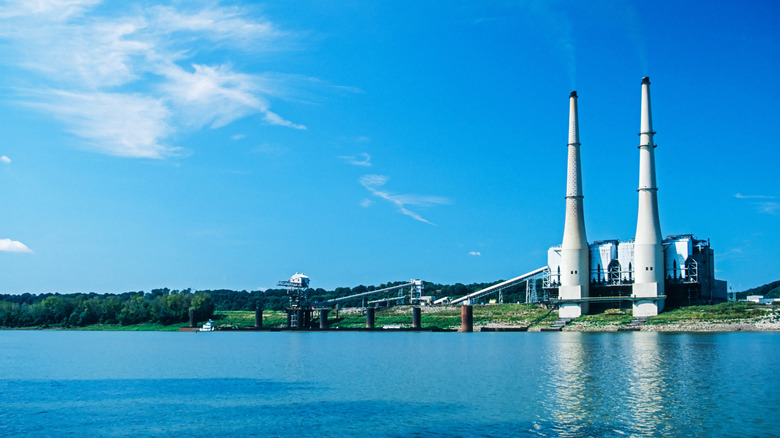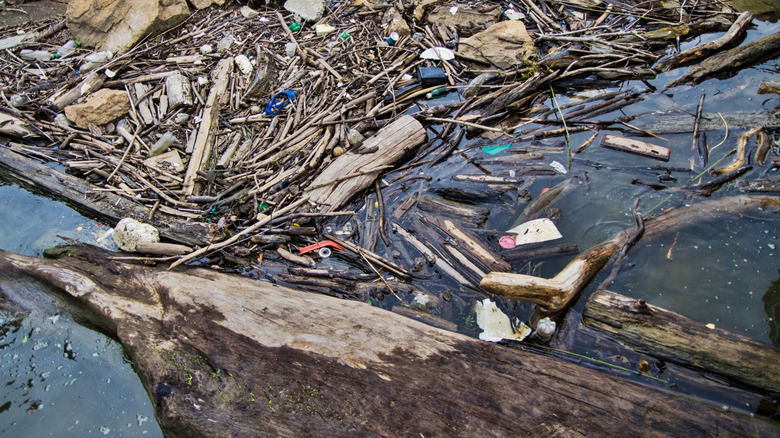One Of America's Dirtiest Rivers Stretches Across Several States And Is Full Of Toxic Chemicals
The United States has numerous stunning bodies of water. For instance, Lake Superior was recently named the cleanest lake in America, with the clear freshwater gem earning an outstanding pollution score of zero out of 10. Unfortunately, not all the country's waterways and recreational areas can claim to be as sanitary, especially when it comes to swimming. The Ohio River, which extends over 980 miles and manages to snake its way through Ohio, Illinois, Kentucky, Indiana, and West Virginia, is considered one of America's most polluted waterways. If you're looking for the reason why it's so dirty, look no further than the power plants, petrochemical plants, and other industrial manufacturers releasing millions of pounds of pollution into the river every year.
In 2020 alone, the Ohio River Basin had over 40 million pounds of pollution from these businesses. That's a huge chunk of the almost 200 million pounds that all waterways across the U.S. received within the past decade, according to a report by Environment America. What's so alarming about this is the types of toxic chemicals that consistently flow through the river, particularly algae-inducing nitrates that can destroy natural ecosystems and cause cancer in humans. Consuming these nitrates can also bring on reproductive problems for adults and lead to developmental issues in children.
Over five million people rely on the Ohio River for drinking water. With the way this river is being treated, that's almost akin to drinking out of a toilet bowl. Not only are industrial manufacturers dumping chemicals into it, but it's also getting agricultural runoff and treated and untreated wastewater from some states. Some of these chemicals don't dilute so easily and remain in the environment, including even the fish, forever. "The basic conclusion here is that we need to stem this toxic tide of pollution in our waterways, and to do it, we are going to need stronger clean water protections," John Rumpler, a clean water program director, said to LPM News.
Cleaning the Ohio River will require federal help
Anti-pollution efforts for the Ohio River have been happening since the 1950s, when the water was so polluted you could smell and taste the acidity. This was back when the water was eating away steel-hulled boats in three years, more than six times faster than normal. In 1990, after the Clean Water Act, the river was starting to function ecologically again, no longer resembling a sewer system. Despite these improvements, much of the Ohio River watershed remains contaminated with dangerous chemicals, such as perfluorooctanoic acid, which makes the water dangerous to consume. Some residents around these parts of the river even blame the water for recurring health defects in the community.
In 2023, the Ohio River was classed as one of the country's most endangered waterways by the nonprofit American Rivers. The crucial role it plays in American culture, health, economy, and environment has put an onus on protecting it. People are demanding more funding for already established Ohio River restoration projects from the federal government. Other agencies are insisting that pollution control standards be improved to stop so much waste from making its way into the water. Unfortunately, this will rely on individual states being proactive about stopping facilities and cities from dumping waste into the river and finding other disposal methods.
Right now, most of the Ohio River isn't impacted by this pollution. You can still find areas along it where you can swim and even drink the water (after it's been treated). New Albany, one of Indiana's oldest Ohio River cities, is a great place to enjoy the river. In Cincinnati, Maysville is another alluring town hidden on the Ohio River and full of historic charm. The fear is that if nothing is done soon, more places like these towns will become victims of life-threatening environmental negligence.

